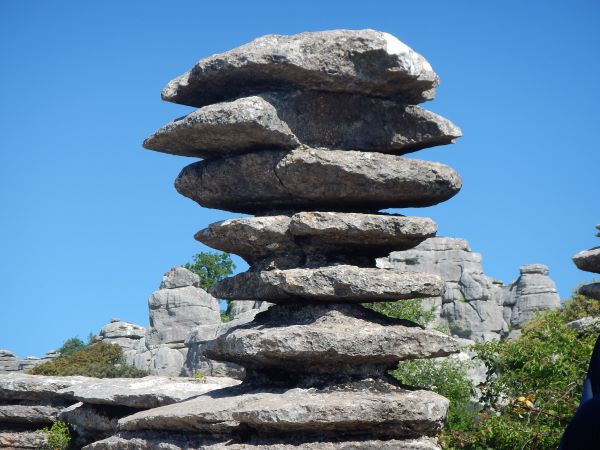Parque Torcal de Antequera
Parque Torcal
El Torcal de Antequera is a special place that surprises you with its strange and varied forms in which the limestone rocks eroded by wind and water over thousands of years.
Located in the province of Malaga, in Andalusia, eight kilometres at the south of Antequera and just 50 kilometers at the north of Málaga, the Natural Park of El Torcal is made of limestone that emerged between 150 and 250 million years ago. At that time, it was a very long sea passage from the Gulf of Cádiz to Alicante, i.e. from the Atlantic to the Mediterranean.
The rocks
The rocks here were originally in the seabed and changed slowly over millions of years. The exuberant flora and fauna constitute an encore in this beautiful place, which is considered to be unique in Europe. El Torcal was also the home of the prehistoric man. Remains of the Neolithic inhabitants can be found in different places and the most important is the Cueva del Toro.
Flora and fauna
El Torcal was the first Andalusian protected area (in 1929) and in 1978 it was declared a nature reserve. Since 1989, it is recognized as a place of interest related to the flora and fauna. The trees that grow in the El Torcal Natural Park are the typical of mountain environments and consists of maple, elderberry bushes, oak trees, hawthorn and blackthorn, interspersed with other plant life, including thyme, ivy, ferns, moss, peonies and irises. When it comes to the animal world, it is known in the area about 150 different species of amphibians, reptiles, birds and mammals, including several species of mountain goats, foxes, mountain cats, lizards, scorpions, snakes, spiders, etc. Many vultures, eagles, eagles, hawks, swifts, falcons and other birds like owls can be found in this area aswell. The place has also been declared a protected area for birds.

Three hikes
The Junta de Andalucia declared the 20 km2 of El Torcal a protected nature park in 1978 and now it attracts more than 120,000 visitors annually.
There are three routes:
A green route of 1.5 kilometers and a yellow trail of three kilometers that can be walked within a half hour or three quarters and for the serious nature lover, there is also a 4.5 mile red route.
In some places the visitor will be surprised with the beautiful view at the Mirador de las Ventanillas. From this point one can see with clear weather the Costa del Sol and even the coast of Africa.
Opening Hours:
The visitor centre with museum and restaurant is open daily from 10:00 to 19:00 hours (April 1-Sept 30) and 10.00-17.00 (1 Oct-30march). On busy days, there is a bus service from the lower parking lot.
How to get there:
From the coast, you drive through the ring road towards Malaga and Sevilla and at the height of Casabermeja take the exit to Villanueva de la Concepcion. From this village you can see the massif mountain and from here there are still about 11 miles more on a good paved road until you get to a point which is 1100 meters above sea level. There, you will find the visitor centre of El Torca
Antequera: worth a visit
A visit to this historical Andalucían town is a journey almost 5,000 years back in time, beginning with the Bronze Age and the native Iberians. The timeline is there to be followed in this fascinating city’s profusion of burial mounds, dolmens, Roman baths, a Moorish Castle, Gothic churches, Renaissance fountains and baroque bell towers.
The first sighting of Antequera in the distance is that of a typical medieval town, with the spires of her many churches and the walls and towers of the great Moorish fortress silhouetted against the sky. Spread out in the valley below lie rich farmlands irrigated by the Guadalhorce River. For centuries this has been one of Andalucía’s most fertile areas, and is currently a leading producer of asparagus, cereals and olives. In summer, its fields turn brilliant yellow with sunflowers.
Fuente de Piedra Natural Reserve
19km from Antequera is the Laguna de Fuente de Piedra, a famous beautiful lagoon. The largest natural lake in the Iberian Peninsula at 2.5km wide and 6.5km long, it is a haven for birds with over 170 different species recorded here.
Apart from its abundant aquatic birds, it is well known for its flamingo population, the second largest colony of these birds in Europe after the French Camargue region and the only inland site on the continent where they breed. In spring flamingos flock here in their thousands to reproduce, attracted by the water’s high salt content and the fact that it is shallow.
Lobo Park Wolf Park
Lobo Park will allow you to observe and understand the dynamics of a wolf pack – one of the most social and team-oriented animals on the planet.
Located in the heart of Andalusia, Spain, and situated on approximately 400.000m² of land for huge enclosures for the wolves, the park was founded by Daniel Weigend and Alexandra Stieber as a private initiative in 2002. However, it opened up to the public in 2004 so that people could come and enjoy a day off with wolves, learning about their various life habits as well as different types of species and how they differ from each other. Pack life styles and dynamics can also be observed at the park.
The Lobo Park arranges guided tours for visitors in both English and Spanish.